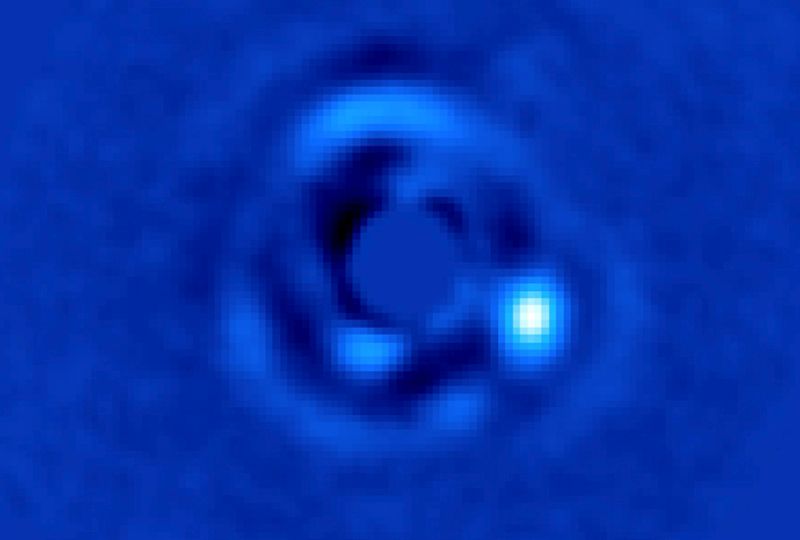The study of exoplanets has advanced a great deal in recent years, thanks in large part to the Kepler mission. But that mission has its limitations. It's difficult for Kepler, and for other technologies, to image regions close to their stars. Now a new instrument called a vortex coronagraph, installed at Hawaii's Keck Observatory, allows astronomers to look at protoplanetary disks that are in very close proximity to the stars they orbit.
The problem with viewing disks of dust, and even planets, close to their stars is that stars are so much brighter than objects that orbit them. Stars can be billions of times brighter than the planets near them, making it almost impossible to see them in the glare. "The power of the vortex lies in its ability to image planets very close to their star, something that we can't do for Earth-like planets yet," said Gene Serabyn of NASA's Jet Propulsion Laboratory (JPL). "The vortex coronagraph may be key to taking the first images of a pale blue dot like our own."
"The power of the vortex lies in its ability to image planets very close to their star, something that we can't do for Earth-like planets yet." - Gene Serabyn, JPL.
"The vortex coronagraph allows us to peer into the regions around stars where giant planets like Jupiter and Saturn supposedly form," said Dmitri Mawet, research scientist at NASA's Jet Propulsion Laboratory and Caltech, both in Pasadena. "Before now, we were only able to image gas giants that are born much farther out. With the vortex, we will be able to see planets orbiting as close to their stars as Jupiter is to our sun, or about two to three times closer than what was possible before."
Rather than masking the light of stars, like other methods of viewing exoplanets, the vortex coronagraph redirects light away from the detectors by combining light waves and cancelling them out. Because there is no occulting mask, the vortex coronagraph can capture images of regions much closer to stars than other coronagraphs can. Dmitri Mawet, research scientist who invented the new coronagraph, compares it to the eye of a storm.

The vortex mask shown at left is made out of synthetic diamond. When viewed with a scanning electron microscope, right, the "vortex" microstructure of the mask is revealed. Image credit: University of Liège/Uppsala University
"The instrument is called a vortex coronagraph because the starlight is centered on an optical singularity, which creates a dark hole at the location of the image of the star," said Mawet. "Hurricanes have a singularity at their centers where the wind speeds drop to zero -- the eye of the storm. Our vortex coronagraph is basically the eye of an optical storm where we send the starlight."
The results from the vortex coronagraph are presented in two papers (here and here) published in the January 2017 Astronomical Journal. One of the studies was led by Gene Serabyn of JPL, who is also head of the Keck vortex project. That study presented the first direct image of HIP79124 B, a brown dwarf that is 23 AU from its star, in the star-forming region called Scorpius-Centaurus.

The vortex coronagraph captured this image of the brown dwarf PIA21417. Image: NASA/JPL-Caltech
"The ability to see very close to stars also allows us to search for planets around more distant stars, where the planets and stars would appear closer together. Having the ability to survey distant stars for planets is important for catching planets still forming," said Serabyn.
"Having the ability to survey distant stars for planets is important for catching planets still forming." - Gene Serabyn, JPL.
The second of the two vortex studies presented images of a protoplanetary disk around the young star HD141569A. That star actually has three disks around it, and the coronagraph was able to capture an image of the innermost ring. Combining the vortex data with data from the Spitzer, WISE, and Herschel missions showed that the planet-forming material in the disk is made up pebble-size grains of olivine. Olivine is one of the most abundant silicates in Earth's mantle.
"The three rings around this young star are nested like Russian dolls and undergoing dramatic changes reminiscent of planetary formation," said Mawet. "We have shown that silicate grains have agglomerated into pebbles, which are the building blocks of planet embryos."
These images and studies are just the beginning for the vortex coronagraph. It will be used to look at many more young planetary systems. In particular, it will look at planets near so-called 'frost lines' in other solar systems. The is the region around star systems where it's cold enough for molecules like water, methane, and carbon dioxide to condense into solid, icy grains. Current thinking says that the frost line is the dividing line between where rocky planets and gas planets are formed. Astronomers hope that the coronagraph can answer questions about hot Jupiters and hot Neptunes.
Hot Jupiters and Neptunes are large gaseous planets that are found very close to their stars. Astronomers want to know if these planets formed close to the frost line then migrated inward towards their stars, because it's impossible for them to form so close to their stars. The question is, what forces caused them to migrate inward? "With a bit of luck, we might catch planets in the process of migrating through the planet-forming disk, by looking at these very young objects," Mawet said.
No comments:
Post a Comment